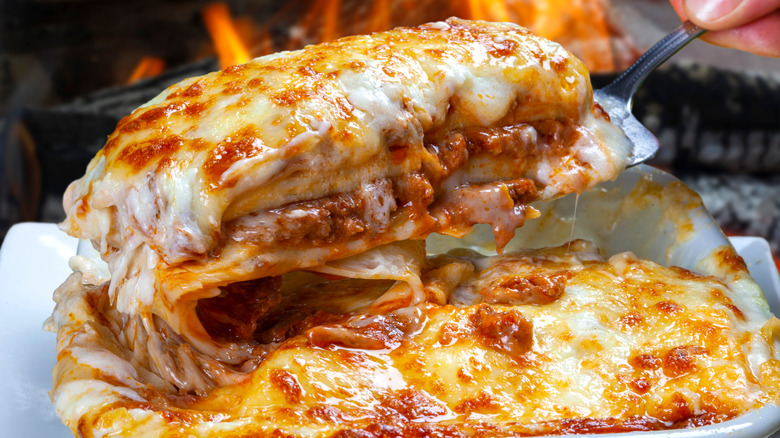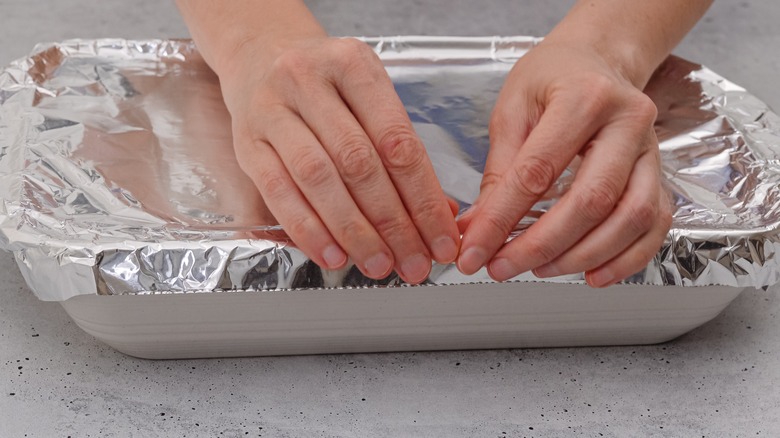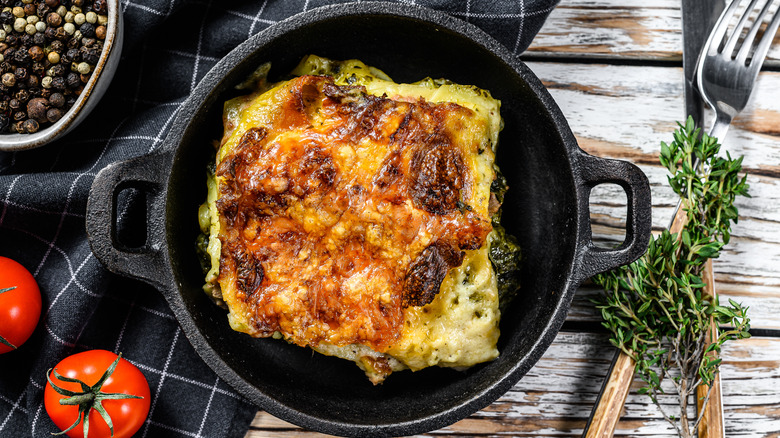The Best Way To Reheat Lasagna So It Tastes Fresh
Whenever you sit down for lasagna, know that there's at least one person at the table who's more excited about the leftovers than the first serving. And since you're reading this, the chances are good that person is you. That late-night snack or day-old lasagna hits differently, and it's not just in (let's say, your) mind. The ingredients in the sauces have had more time to meld, giving the dish a more rounded flavor, and the layers are more tightly held together because of the time spent in the fridge. But how best to reheat it?
While the microwave is the quickest option, it will likely turn that layered beauty into mush. Lasagna noodles, especially those you precook before assembling the dish, are particularly susceptible to losing structure. It'll still taste great, but those distinct layers of pasta and sauce will largely be lost. Another option is reheating on the skillet, which requires a bit of elbow grease but will reward you with crisp edges.
The oven hits the sweet spot between taste and convenience when reheating leftover lasagna. All you have to ensure is that it doesn't dry out, so make sure the dish remains covered during the reheating process and avoid your oven's convection setting. The result is a decadent, gooey, layered lasagna that maintains its original flavor and structure. These reheating tricks also work with frozen lasagna, which, if that's the route you've gone, should be thawed overnight in the fridge for best results.
The secret to reheating lasagna is maintaining moisture
One of the most important aspects of reheating lasagna is ensuring it doesn't dry out. If the lasagna is heated uncovered in the oven, the thick sauces turn pasty, the noodles dry out, and the top layer of cheese becomes chewy and hard. Covering your baking tray with aluminum foil before placing it in the oven helps keep that crucial moisture inside, and you are rewarded with bubbly cheese and reawakened sauces.
To ensure the melted cheese on top doesn't stick to the foil, poke a few toothpicks into the lasagna. In addition to holding the layers firm, they also act as spacers — though work carefully to not poke a hole in the foil. To get the lasagna to the right consistency, it should be reheated in the oven at 350 degrees Fahrenheit for between 30 and 45 minutes (depending on the portion size).
While this method will get your leftover lasagna tasting decadent, if you're after even more of a fresh-out-the-oven experience, consider topping it with some leftover sauce and a fresh sprinkle of cheese before placing it in the oven. If you've added cheese, remove the foil covering for the last 10 minutes that your lasagna spends in the oven to crisp up the top layer. Garnish with some chopped fresh basil or parsley to add a dash of freshness, and your reheated lasagna will taste as good as (or hopefully better than) when it was first dished up.
Quick ways to reheat lasagna
It's only natural to want a quick method to reheat lasagna since you already put in the arduous hours to prepare it the first time. While the oven is the best way to get leftover lasagna tasting fresh, you can use the microwave or a skillet for faster turnaround. Expect the consistency and layers to be slightly compromised, but you'll still get all that delicious flavor.
When reheating lasagna in the microwave, drizzle some water over on top to prevent it from drying out and heat on medium for about a minute. You can also add some fresh grated cheese, which the microwave's high heat will quickly melt (but, unfortunately, not brown).
Reheating leftover lasagna on the skillet requires a bit of complex maneuvering but is the best way to get some of those crispy caramelized bits back. Grease the skillet with olive oil before carefully placing your cold block of lasagna on it. Then, sprinkle some water on the skillet and cover for a few minutes so the steam heats the lasagna through. Maintain heat at medium-high throughout the process, and cook uncovered until the bottom gets a lightly crunchy texture. If you're feeling adventurous, you can slice the lasagna into thin pieces and lay them on their sides on a skillet until crisp. As usual, if you've got some leftover sauce, use it to spruce up leftover lasagna, no matter which way you heat it.


